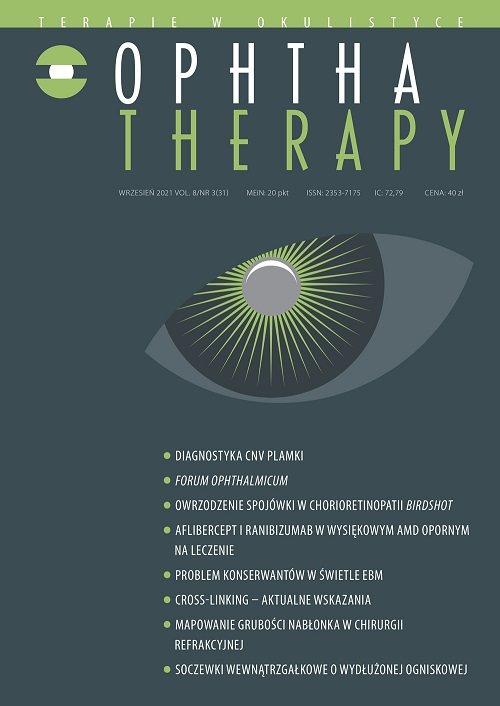The issue of preservatives in light of evidence based medicine Review article
Main Article Content
Abstract
Glaucoma is the leading cause of irreversible blindness worldwide. Most patients will require drug therapy for the rest of their lives. Preservatives play a key role in the development of topical medications whose primary role is to provide antimicrobial activity to maintain sterility. The most common preservative is benzalkonium chloride, which has antibacterial, antifungal, and antiviral properties. This article was written based on the latest research in MEDLINE and other major bibliographic databases for studies published in English by August 1st, 2021. Our meta-analyses confirm that eye drops side effects are not caused solely by the presence of preservatives, and the effectiveness of anti-glaucoma drugs containing benzalkonium chloride and those without preservatives is comparable. During the COVID-19 pandemic, studies showed the protective effect of preservatives against SARS-CoV-2.
Downloads
Article Details

This work is licensed under a Creative Commons Attribution-NonCommercial-NoDerivatives 4.0 International License.
Copyright: © Medical Education sp. z o.o. License allowing third parties to copy and redistribute the material in any medium or format and to remix, transform, and build upon the material, provided the original work is properly cited and states its license.
Address reprint requests to: Medical Education, Marcin Kuźma (marcin.kuzma@mededu.pl)
References
2. Freeman PD, Kahook MY. Preservatives in topical ophthalmic medications: historical and clinical perspectives. Expert Rev Ophthalmol. 2009; 4: 59-64.
3. Broadway DC, Grierson I, O’Brien C et al. Adverse effects of topical antiglaucoma medication. ii. the outcome of filtration surgery. Arch Ophthalmol. 1994; 112: 1446-54.
4. Baudouin C, Labbé A, Liang H et al. Preservatives in eyedrops: the good, the bad and the ugly. Prog Retin Eye Res. 2010; 29: 312-34.
5. Majumdar S, Hippalgaonkar K, Repka MA. Effect of chitosan, benzalkonium chloride and ethylenediaminetetraacetic acid on permeation of acyclovir across isolated rabbit cornea. Int J Pharm. 2008; 348: 175-8.
6. Yenice I, Mocan MC, Palaska E et al. Hyaluronic acid coated poly-epsilon-caprolactone nanospheres deliver high concentrations of cyclosporine a into the cornea. Exp Eye Res. 2008; 87: 162-7.
7. Anwar Z, Wellik SR, Galor A. Glaucoma therapy and ocular surface disease: current literature and recommendations. Curr Opin Ophthalmol. 2013; 24: 136-43.
8. Hedengran A, Steensberg AT, Virgili G et al. Efficacy and safety evaluation of benzalkonium chloride preserved eye-drops compared with alternatively preserved and preservative-free eye-drops in the treatment of glaucoma: a systematic review and meta-analysis. Br J Ophthalmol. 2020; 104(11): 1512-8. https://doi.org/10.1136/bjophthalmol-2019-315623.
9. Pellinen P, Huhtala A, Tolonen A et al. The cytotoxic effects of preserved and preservative-free prostaglandin analogs on human corneal and conjunctival epithelium in vitro and the distribution of benzalkonium chloride homologs in ocular surface tissues in vivo. Curr Eye Res. 2012; 37: 145-54.
10. European Glaucoma Society Terminology and Guidelines for Glaucoma, 5th Edition.
11. Golberg I, Gil Pina R, Lanzagorta-Aresti A et al. Bimatoprost 0,03% Timolol 0,5% preservative-free ophthallic solution versus bimatoprost 0,03% Timolol 0,5% ophthalmic solution (Ganfort) for glaucoma or ocular hypertension: a 12-week randomized controlled trail. Br J Ophthalmol. 2014; 98(7): 926-31.
12. Shedden A, Adamsons IA, Getson AJ et al. Comparison of the efficacy and tolerability of preservative-free and preservative-containing formulations of the dorzolamide/timolol fixed combination (COSOPT tm) in the patients with elevated intraocular pressure in a randomized clinical trial. Graefes Arch Clin Exp Ophthalmol. 2010; 248(12): 1757-64.
13. Day DG, Walters TR, Schwartz GF et al. Bimatoprost 0,03% preservative free ophthalmic solution versus bimatoprost 0,03% ophthalmic solution (Lumigan) for glaucoma or ocular hypertension: a 12-week, randomized, double-masked trial. Br J Ophthalmol. 2013; 97(8): 989-93.
14. Aptel F, Choudhry R, Stalmans I. Preservative-free versus preserved latanoprost eye drops in patients with open-angle glaucoma or ocular hypertension. Curr Med Res Opin. 2016; 32(8): 1457-63.
15. Katz G, Springs CL, Craven ER et al. Ocular surface disease in patiens with glaucoma or ocular hypertension treated with either BAK-preserved latanoprost or BAK-free travoprost. Clin Ophthalmol. 2010; 4: 1253-61.
16. Pisella PJ, Pouliquen P, Baudouin C. Prevalence of ocular symptoms and signs with preserved and preservative free glaucoma medication. Br J Ophthalmol. 2002; 86(4): 418-23.
17. Trocme S, Hwang LJ, Bean GW et al. The role of benzalkonium chloride in the occurrence of punctate keratitis: a meta-analysys of randomized, controlled clinical trials. Ann Pharmacother. 2010; 44(12): 1914-21.
18. Hirose R, Bandou R, Ikegaya H et al. Disinfectant effectiveness against SARS-CoV-2 and influenza viruses present on human skin: model-based evaluation. Clin Microbiol Infect. 2021; 27(7): 1042.e1-1042.e4. https://doi.org/10.1016/j.cmi.2021.04.009.

